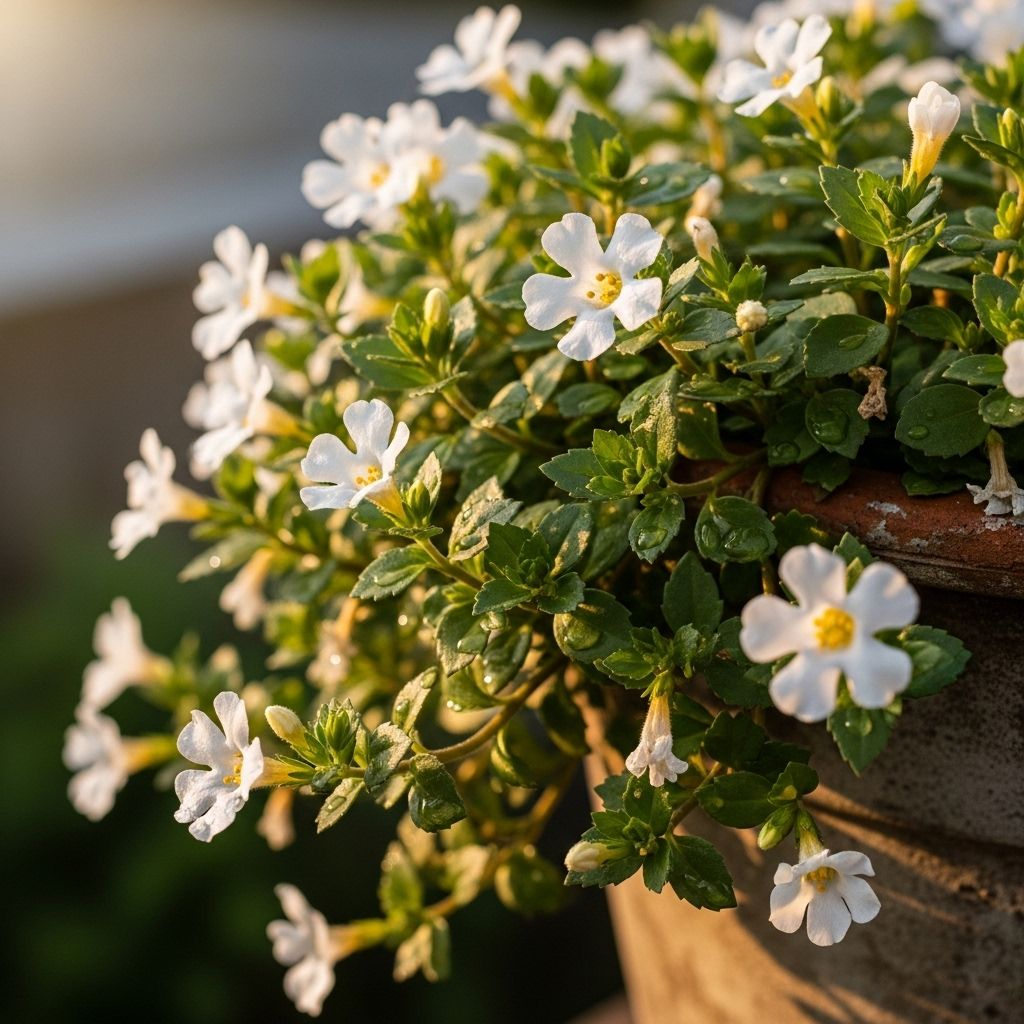Bacopa Plant Care: 3 Essential Tips For Continuous Blooms
Discover how to grow and care for this elegant trailing plant that brings charm to containers and landscapes

Image: HearthJunction Design Team
All About Bacopa
Bacopa (Sutera cordata, also sold as Bacopa monnieri or Chaenostoma cordatum) is a charming, cascading annual that has gained popularity among gardeners for its delicate flowers and trailing habit. This versatile plant originated in South Africa and has become a favorite for containers, hanging baskets, and garden borders across various climates. With its ability to produce a continuous display of small, dainty blooms throughout the growing season, bacopa adds a touch of elegance to any garden space.
The plant features small, rounded leaves that create a lush green backdrop for its prolific flowers. Bacopa blooms come in several colors, including white, blue, lavender, and pink, making it easy to incorporate into various garden color schemes. Its trailing habit can extend up to 2 feet, creating beautiful cascades of color when planted in elevated containers or hanging baskets.
Bacopa Plant Characteristics
Bacopa is valued for its consistent flowering and adaptable nature. Unlike some annuals that may experience flowering gaps, bacopa tends to bloom continuously from spring through fall in most growing zones. The plant produces small, five-petaled flowers approximately half an inch in diameter that cover the stems, creating a carpet-like effect of delicate blooms.
While most commonly grown as an annual, bacopa can be perennial in USDA Hardiness Zones 9-11 where winters are mild. In these warmer regions, the plant may continue growing year-round, providing extended seasonal interest. In cooler climates, gardeners typically treat bacopa as an annual, replanting each spring after the threat of frost has passed.
The growth habit of bacopa makes it particularly versatile in garden design. Its naturally spreading, trailing tendency allows it to spill beautifully over the edges of containers, creating soft, flowing cascades that can reach 12-24 inches in length. This characteristic makes bacopa an excellent choice for hanging baskets, window boxes, and raised planters where its trailing stems can be showcased to full advantage.
How to Grow Bacopa
Bacopa is relatively easy to grow, making it suitable for gardeners of all experience levels. While it can be grown from seed, most gardeners purchase young plants from nurseries or garden centers in spring for immediate planting. This approach provides faster results and eliminates the challenges sometimes associated with seed germination.
Light Requirements
Bacopa thrives in locations that receive partial sun to partial shade. In cooler climates, the plant can tolerate more direct sunlight, particularly morning sun with afternoon shade. In hotter regions, protection from intense afternoon sun is beneficial to prevent wilting and flower drop. The ideal light condition provides approximately 4-6 hours of sunlight daily, preferably during the cooler parts of the day.
Soil Preferences
This versatile annual performs best in well-draining soil that remains consistently moist but not waterlogged. When planting in containers, use a high-quality potting mix that contains peat moss or coconut coir to help retain moisture while still allowing excess water to drain away. For garden beds, amend heavy clay soils with compost to improve drainage and add organic matter to sandy soils to enhance moisture retention.
Watering Needs
Consistent moisture is crucial for bacopa’s continued flowering and overall health. Unlike some drought-tolerant annuals, bacopa quickly shows stress when it becomes too dry, often dropping flowers and taking time to recover. Establish a regular watering schedule, checking container plants daily during hot weather as they dry out more quickly than those planted in the ground. Apply water when the top inch of soil feels dry to the touch, being careful not to oversaturate.
Temperature Tolerance
Bacopa performs best in moderate temperatures between 65-75°F (18-24°C). While it can withstand occasional heat spikes, prolonged hot periods above 85°F (29°C) may cause stress and reduced flowering. Similarly, the plant is sensitive to cold and may suffer damage when temperatures drop below 40°F (4°C). In regions with hot summers, providing afternoon shade can help maintain plant vigor during the hottest months.
Bacopa Plant Care
Proper care ensures that bacopa remains lush and flowering throughout its growing season. While not particularly demanding, attention to a few key maintenance tasks will keep your plants looking their best.
Fertilizing
Regular feeding supports bacopa’s continuous blooming habit. Apply a balanced, water-soluble fertilizer formulated for flowering plants every 2-3 weeks during the growing season. Container-grown bacopa may require more frequent feeding as nutrients leach more quickly from pots. Alternatively, incorporate a slow-release fertilizer into the soil at planting time to provide a steady nutrient supply over several months.
Pruning and Maintenance
While bacopa generally maintains a neat, compact habit, occasional light pruning can encourage bushier growth and prevent plants from becoming leggy. If stems begin to stretch or flowering diminishes, trim back about one-third of the plant’s length to stimulate new growth and blooms. Unlike some annual flowers, bacopa doesn’t typically require deadheading as it naturally sheds spent blooms and continues producing new ones.
In mid-summer, particularly in hot climates, plants may benefit from a more substantial trim if they begin to look tired or straggly. This rejuvenation pruning, removing up to half of the plant’s growth, can revitalize bacopa for continued performance through the fall months.
Pest and Disease Management
Bacopa is generally resistant to serious pest and disease problems, making it a relatively carefree addition to the garden. Occasionally, aphids, spider mites, or whiteflies may appear, particularly when plants are stressed by improper growing conditions. Regular inspection of plants allows for early detection and treatment with insecticidal soap or neem oil if necessary.
Root rot can occur in overly wet conditions, so proper drainage and careful watering are important preventive measures. Powdery mildew may develop in humid conditions with poor air circulation, particularly when plants are crowded. Spacing plants appropriately and watering at the soil level rather than overhead can help minimize this issue.
Landscape Design with Bacopa
Bacopa’s versatility makes it valuable in various garden settings and design styles. Its cascading habit is particularly effective in elevated plantings where the trailing stems can be showcased.
Container Gardens
In container arrangements, bacopa works beautifully as a “spiller” component, softening the edges of pots and creating visual flow. Combine it with upright “thriller” plants like angelonia or salvia and mounding “filler” plants such as calibrachoa or compact petunias for balanced, three-dimensional container designs. The plant’s ability to trail makes it perfect for hanging baskets, window boxes, and tall planters where its cascading habit can be fully appreciated.
Ground Cover and Border Plantings
In garden beds, bacopa can function as a flowing ground cover, creating carpets of delicate blooms between larger perennials or shrubs. Plant it along the front of borders where it can spill slightly onto pathways, softening hard edges and adding movement to the landscape. Its relatively shallow root system makes bacopa suitable for planting between stepping stones or in rock gardens where soil depth may be limited.
Color Combinations
The various color options available in bacopa allow for creative garden color schemes. White varieties add brightness and visual space to plantings, while blue and purple selections create cool, calming effects. Pink varieties blend beautifully with other pastel flowers for romantic garden themes. Consider pairing bacopa with complementary or contrasting colors based on your preferred garden palette – white bacopa looks striking against dark foliage plants, while blue varieties harmonize with silver-leaved companions.
Bacopa Varieties to Try
Plant breeders have developed numerous bacopa varieties with improved heat tolerance, larger flowers, and expanded color options. Here are some popular selections worth considering for your garden:
- Snowtopia – Features pristine white blooms and excellent heat tolerance, making it reliable even in warmer climates.
- Blutopia – Produces masses of lavender-blue flowers that blend beautifully with many other garden plants.
- Pinktopia – Offers soft pink blooms that add a gentle touch of color to container arrangements.
- Great White – Known for larger white flowers and vigorous growth, with trails reaching up to 2 feet long.
- MegaCopa – A series with improved heat resistance and larger flowers in various colors including white, blue, and pink.
Bacopa Compared to Other Trailing Annuals
When planning your garden, it’s helpful to understand how bacopa compares to other popular trailing annuals that might serve similar functions in the landscape. Each plant has distinct characteristics that make it suitable for specific conditions or design applications.
| Feature | Bacopa | Calibrachoa | Trailing Lobelia |
|---|---|---|---|
| Flower Size | Small (½ inch) | Medium (1 inch) | Small (½ inch) |
| Heat Tolerance | Moderate | Good to Excellent | Poor |
| Water Needs | Consistent moisture | Moderate | Regular moisture |
| Sun Preference | Part sun to part shade | Full sun to part sun | Part sun to part shade |
| Trailing Length | 12-24 inches | 12-18 inches | 6-12 inches |
Bacopa Health Benefits
Beyond its ornamental value, Bacopa monnieri (a close relative of the ornamental bacopa) has been used in traditional Ayurvedic medicine for centuries. This medicinal bacopa, sometimes called Brahmi, is known for its potential cognitive benefits and is distinctly different from the ornamental varieties typically grown in gardens.
Medicinal bacopa has been studied for its potential to improve memory, reduce anxiety, and enhance cognitive function. Research suggests it may contain compounds that protect brain cells and influence certain neurotransmitters involved in learning and memory. While scientific investigation continues, some studies indicate that bacopa extracts may help reduce inflammation, lower blood pressure, and even assist with symptoms of attention deficit-hyperactivity disorder (ADHD).
It’s important to note that ornamental bacopa varieties used in gardens are not typically used for medicinal purposes. Anyone interested in bacopa for health benefits should consult with healthcare providers and use products specifically formulated for medicinal use rather than garden varieties.
Frequently Asked Questions
Q: Will bacopa come back every year?
A: In most regions (USDA Zones 2-8), bacopa is grown as an annual and will not survive winter temperatures. However, in warmer climates (Zones 9-11), it can function as a perennial and return year after year with proper care.
Q: Why did my bacopa stop flowering?
A: The most common reason for reduced flowering is inconsistent watering, particularly allowing the plant to dry out completely. Other potential causes include insufficient light, extreme heat, or nutrient deficiencies. Ensuring consistent moisture, proper light conditions, and regular fertilization will help maintain continuous blooming.
Q: Can bacopa be overwintered indoors?
A: Yes, bacopa can be brought indoors before the first frost and kept as a houseplant in a bright location. Trim back by about one-third before bringing indoors, maintain moderate humidity, and provide bright, indirect light. While it may not flower as prolifically indoors, healthy plants can be returned to outdoor locations after the danger of frost has passed in spring.
Q: How often should I water my bacopa?
A: Bacopa requires consistent moisture to thrive. In containers, this typically means watering every 1-2 days during warm weather, possibly daily during hot spells. Garden-planted bacopa generally needs watering 2-3 times weekly, depending on rainfall and temperature. Always check soil moisture before watering, and ensure the soil is moist but not waterlogged.
Q: Does bacopa attract pollinators?
A: Yes, bacopa flowers can attract small pollinators, particularly bees and butterflies. While not considered a primary pollinator plant, its consistent blooming does provide a steady nectar source throughout the growing season, making it a welcome addition to pollinator-friendly gardens.
References
- https://www.webmd.com/vitamins/ai/ingredientmono-761/bacopa
- https://www.banyanbotanicals.com/pages/plants-bacopa-benefits
- https://costafarms.com/blogs/plant-finder/bacopa
- https://www.health.com/bacopa-benefits-8760026
- https://www.merckmanuals.com/home/special-subjects/dietary-supplements-and-vitamins/bacopa
Read full bio of Srija Burman












